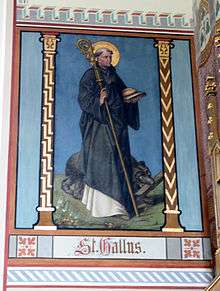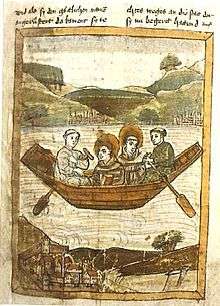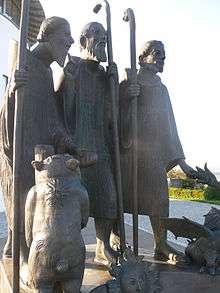Saint Gall
Saint Gall, or Gallus (c. 550 – c. 646, German: Sankt Gallus) according to hagiographic tradition was a disciple and one of the traditional twelve companions of Saint Columbanus on his mission from Ireland to the continent. Saint Deicolus was the elder brother of Gall.[2]
Saint Gall | |
|---|---|
 Saint Gall | |
| Patron of Saint Gall | |
| Born | 550 Ireland |
| Died | 646 Arbon |
| Venerated in | Roman Catholic Church Eastern Orthodox Church Church of Ireland |
| Major shrine | Abbey of Saint Gall |
| Feast | 16 October |
| Attributes | Portrayed as an abbot blessing a bear that brings him a log of wood; may be shown holding a hermit's tau staff with the bear or carrying a loaf and a pilgrim's staff.<[1] |
| Patronage | birds geese poultry Switzerland St. Gallen[1] |
Biography

The fragmentary oldest Life was recast in the 9th century by two monks of Reichenau, enlarged in 816–824 by Wettinus,[3] and about 833–884 by Walafrid Strabo, who also revised a book of the miracles of the saint. Other works ascribed to Walafrid tell of Saint Gall in prose and verse.
Gallus' origin is a matter of dispute. According to his 9th-century biographers in Reichenau, he was from Ireland and entered Europe as a companion of Columbanus. The Irish origin of the historical Gallus was called into question by Hilty (2001), who proposed it as more likely that he was from the Vosges or Alsace region. Schär (2010) proposed that Gallus may have been of Irish descent but born and raised in the Alsace.[4]
According to the 9th-century hagiographies, Gallus as a young man went to study under Comgall of Bangor Abbey. The monastery at Bangor had become renowned throughout Europe as a great centre of Christian learning. Studying in Bangor at the same time as Gall was Columbanus, who with twelve companions, set out about the year 589.[5]
Gall and his companions established themselves with Columbanus at first at Luxeuil in Gaul. In 610, St. Columban was exiled by leaders opposed to Christianity and fled with St. Gall to Alemannia.[6] He accompanied Columbanus on his voyage up the Rhine River to Bregenz but when in 612 Columbanus travelled on to Italy from Bregenz, Gall had to remain behind due to illness and was nursed at Arbon. He remained in Alemannia, where, with several companions, he led the life of a hermit in the forests southwest of Lake Constance, near the source of the river Steinach.[7] Cells were soon added for twelve monks whom Gall carefully instructed.[8] Gall was soon known in Switzerland as a powerful preacher.
When the See of Constance became vacant, the clergy who assembled to elect a new Bishop were unanimously in favour of Gall. He, however, refused, pleading that the election of a stranger would be contrary to Church law. Some time later, in the year 625, on the death of Eustasius, abbott of Luxeuil, a monastery founded by Saint Columbanus, members of that community were sent by the monks to request Saint Gall to undertake the government of the monastery. He refused to quit his life of solitude, and undertake any office of rank which might involve him in the cares of the world. He was then an old man.[5]
He died at the age of ninety-five around 646–650 in Arbon.[6]

Legends
From as early as the 9th century a series of fantastically embroidered Lives of Saint Gall were circulated. Prominent was the story in which Gall delivered Fridiburga from the demon by which she was possessed. Fridiburga was the betrothed of Sigebert II, King of the Franks, who had granted an estate at Arbon (which belonged to the royal treasury) to Gall so that he might found a monastery there.[7]
Another popular story has it that as St Gall was travelling in the woods of what is now Switzerland he was sitting one evening warming his hands at a fire. A bear emerged from the woods and charged. The holy man rebuked the bear, so awed by his presence it stopped its attack and slunk off to the trees. There it gathered firewood before returning to share the heat of the fire with St Gall. The legend says that for the rest of his days St Gall was followed around by his companion the bear.[9]
Veneration
His feast is celebrated on 16 October.[10]
Iconography
Images of St. Gall typically represent him standing with a bear.[6]
Legacy
When Columbanus, Gall and their companions left Ireland for mainland Europe, they took with them learning and the written word. Their effect on the historical record was significant as the books were painstakingly reproduced on vellum by monks across Europe. Many of the Irish texts destroyed in Ireland during Viking raids were preserved in Abbeys across the channel.[9]
Abbey of St. Gall
After his death, a small church was erected which developed into the Abbey of St. Gall, the nucleus of the Canton of St. Gallen in eastern Switzerland the first abbot of which was Saint Othmar. The monastery was freed from its dependence of the bishop of Constance and Emperor Louis the Pious made it an imperial institution. The "Abbey of St. Gall", (not from the name of its founder and first abbot, but of the saint who had lived in this place and whose relics were honoured there) the monastery and especially its celebrated scriptorium played an illustrious part in Catholic and intellectual history until it was secularised in 1798.[7]
In popular culture
St Gall is the name of a wheel shaped hard cheese made from the milk of Friesian cows, which won a Gold Medal at the World Cheese Awards held in Dublin 2008.[11]
Robertson Davies, in his book, The Manticore, interprets the legend in Jungian psychological terms. In the final scene of the novel where David Staunton is celebrating Christmas with Lizelloti Fitziputli, Magnus Eisengrim, and Dunstan Ramsay he is given a gingerbread bear. Ramsay explains that Saint Gall made a pact of peace with a bear who was terrorising the citizens of the nearby village. They would feed him gingerbread and he would refrain from eating them. The parable is a Jungian exhortation to make peace with one's dark side.
Notes
- "Saint of the Day, October 16:". St. Patrick Catholic Church. Retrieved 8 March 2012.
- Grattan-Flood, William. "St. Deicolus." The Catholic Encyclopedia Vol. 4. New York: Robert Appleton Company, 1908. 2 June 2018
- English translation in Throop, Priscilla, trans., The Life of Saint Gall, Charlotte, VT: MedievalMS, 2010.
- Gallus und die Sprachgeschichte der Nordostschweiz, St Gallen, 2001. Max Schär, "Woher kam der heilige Gallus?", Studien und Mitteilungen zur Geschichte des Benediktinerordens und seiner Zweige vol. 121. St. Ottilien 2010, 71–94.
- "Who was St. Gall", St. Gall's Church, Bangor, County Down, Northern Ireland
- "Who was St. Gall?", St. Gall School, Chicago, Illinois
- Poncelot, Albert. "St. Gall." The Catholic Encyclopedia. Vol. 6. New York: Robert Appleton Company, 1909. 17 Apr. 2013
- "Saint Gall", Orthodox Outlet for Dogmatic Enquiries
- "St. Gall's Bear", St. Gall's Church, Bangor, County Down, Northern Ireland
- Butler, Alban. The Lives of the Saints, Vol. X, 1866
- The Irish Farmhouse Cheesemakers Association Archived 19 October 2013 at the Wayback Machine
Bibliography
- Joynt, Maud, tr. and ed., The Life of St Gall, Llanerch Press, Burnham-on-Sea, 1927. ISBN 0-947992-91-X
- Schär, Max, Gallus. Der Heikiger in seiner Zeit, Schwabe Verlag, Basle, 2011. ISBN 978-3-7965-2749-4
- Schmid, Christian, Gallusland. Auf den Spuren des heiligen Gallus, Paulus Verlag, Fribourg, 2011. ISBN 978-3-7228-0794-2
- Music and musicians in medieval Irish society, Ann Buckley, pp. 165–190, Early Music xxviii, no.2, May 2000
- Music in Prehistoric and Medieval Ireland, Ann Buckley, pp. 744–813, in A New History of Ireland, volume one, Oxford, 2005
External links
| Wikimedia Commons has media related to Saint Gall. |